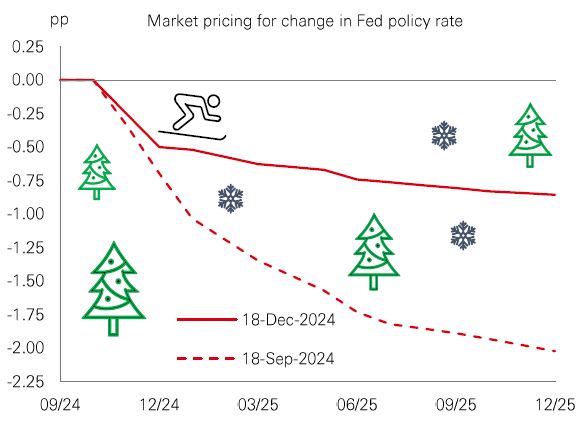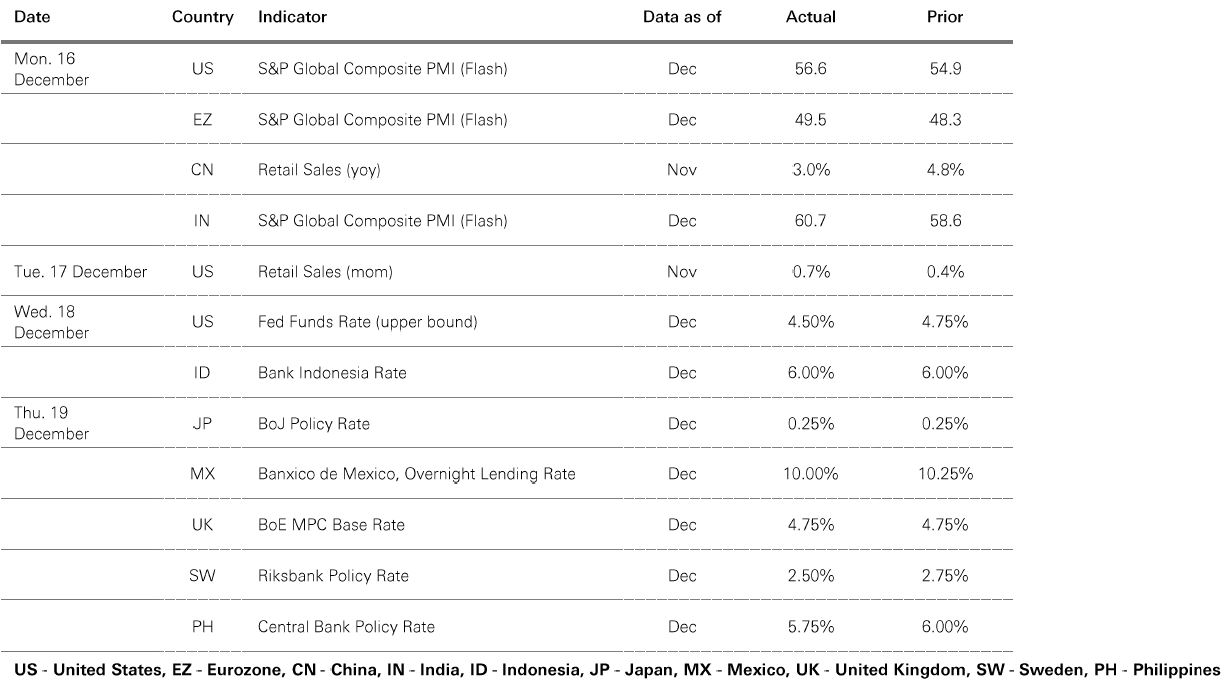
23 December 2024

The story of investment markets in 2024 has been dominated by the course of disinflation and the global rate-cutting cycle. Last week’s sell-off in global stocks on a more hawkish Fed outlook showed how hyper-sensitive markets are to disappointing macro news. But Q4 has delivered some extra twists and turns, including the outcome of the US presidential election. The result raised uncertainty over future US policy, spurred strong moves in global risk assets, and drove a rally in the US dollar. It even got some credit for a surge in the price of cryptocurrencies.
In stocks, the strongest momentum has been in US large caps, especially in tech-related sectors. Despite last week’s moves, the S&P 500 is still up in Q4 (and up by more than 20%+ this year). Growth has thrived while value has lagged. But it was emerging market equities – which have been strong in 2024 – that felt the most pain in Q4 (see Page 2).
In fixed income, the potential for inflationary policy and higher-for-longer rates saw US Treasury yields rise. In credit, High Yield and ABS were more muted in Q4 (but have been strong in 2024 overall). Meanwhile in alternative assets, Q4 was weak but diversifiers like hedge funds, private credit, and real estate are on course to finish the year positively.
So, what comes next? We think that active fiscal policy, trade uncertainty, and geopolitical tensions may cause volatility and could leave investors ‘spinning around’ in 2025. And despite the moves in Q4, there is scope for performance to broaden out to developed markets beyond North America, as well as emerging and frontier markets next year (see Market Spotlight).
Overall market returns in 2024 are on track to be very solid. The good news for investors heading into next year is that global growth remains resilient, AI is driving revenue growth (and economic productivity), and central banks are still expected to cut rates. But could signs of inflation persistence force a more gradual easing path? This would pose obvious challenges to market performance, reflected in last week’s Fed-induced market wobble. The most expensive parts of the market (US tech) – which look priced for perfection – could be vulnerable, especially if profits disappoint.
If the US market starts to struggle, can other regions take the lead? Many markets outside of the US benefit from favourable valuations and improving profit growth. But for most EMs, a lot will depend on the course of the US dollar, the potency of China policy easing, and developments around trade policy. And for Europe, can the politics tilt in a more investor-friendly direction? Fiscal policy developments in France and Germany will be important.
Finally, could a pickup in market volatility support the performance of defensive sectors - healthcare, staples, utilities – that have lagged this year? With these sectors also acting as “bond proxies”, the direction of rates will also matter.
The value of investments and any income from them can go down as well as up and investors may not get back the amount originally invested. Past performance does not predict future returns. For informational purposes only and should not be construed as a recommendation to invest in the specific country, product, strategy, sector or security. Any views expressed were held at the time of preparation and are subject to change without notice. Any forecast, projection or target where provided is indicative only and is not guaranteed in any way.
Source: HSBC Asset Management. Macrobond, Bloomberg. Data as at 7.30am UK time 20 December 2024.
The Fed cut rates as expected at its December meeting but the FOMC’s revised projections unsettled markets. Upward revisions to inflation resulted in the removal of two rate cuts in 2025 – the Fed now expects to reduce the funds rate by 0.5% next year, rather than 1%. Chair Powell noted that following a sticky patch in recent months, evidence that inflation was again moving towards target would be needed before the Fed sanctions another cut. A pause in early 2025 looks likely.
Treasury yields jumped by over 0.1% and the USD hit its highest level since 2022 as markets moved to price in a slower pace of policy easing. But the biggest move came in equities – the S&P 500 fell 3% on the day.
The market is now pricing in a very shallow slope for policy easing – only 1-2 cuts in 2025. Combined with significant Treasury issuance, this has pushed the 10yr yield back above 4.50%. This maintains a solid income component for fixed income investors. And on a cyclical basis, if inflation were to decline more quickly than expected – possible given its hitherto bumpy path – or growth disappoints, Treasury yields could fall back.

Stock markets in emerging and frontier economies have delivered a broadly positive performance in 2024 – but Q4 has been difficult.
In part, recent weakness is down to the headwind of a resurgent US dollar, which has rallied since early October. Concerns over higher-for-longer US rates and heightened trade tensions have added to the woes. These factors have complicated an already challenging domestic backdrop for Latam countries like Brazil. And together with a weak profits outlook, that led to a big decline for the region’s stocks in Q4.
Policy uncertainty has also dragged on markets in EM ASEAN, where financial stocks (which have a high weighting in regional indices) have weakened. Mainland Chinese stocks have also lost ground in Q4. But year-to-date, mainland China, together with Taiwan and India, remains among the strongest EM performers this year. Even excluding mainland China, the benefit of idiosyncratic trends and strong structural growth stories have helped broader EM, Asia, and Frontier stock universes to perform well in 2024.

In recent weeks, China’s longer-dated government bond yields have fallen below those of Japan, in a historic shift that reflects significant developments in both economies.
The global inflation shock boosted Japanese nominal GDP and appears to have triggered a “virtuous cycle” in wages and prices. While the BoJ opted not to hike at its December meeting, markets expect 0.4%-0.5% of tightening in 2025. This move away from deflation, the expectation of gradual policy normalisation, and higher US Treasury yields, have combined to push longer-dated Japanese yields higher.
In contrast, Chinese bond yields have trended lower since the pandemic, reflecting a period of weak inflation, lingering growth concerns, and ongoing PBOC easing expectations. December’s Politburo meeting called for “moderately loose” monetary policy, pointing to further rate cuts.

Past performance does not predict future returns. The level of yield is not guaranteed and may rise or fall in the future. For informational purposes only and should not be construed as a recommendation to invest in the specific country, product, strategy, sector or security. Any views expressed were held at the time of preparation and are subject to change without notice. Index returns assume reinvestment of all distributions and do not reflect fees or expenses. You cannot invest directly in an index. Any forecast, projection or target where provided is indicative only and not guaranteed in any way. Diversification does not ensure a profit or protect against loss. Source: HSBC Asset Management. Macrobond, Bloomberg, Datastream. Data as at 7.30am UK time 20 December 2024.


Source: HSBC Asset Management. Data as at 7.30am UK time 23 December 2024. For informational purposes only and should not be construed as a recommendation to invest in the specific country, product, strategy, sector or security. Any views expressed were held at the time of preparation and are subject to change without notice.
The US Fed lowered rates by 0.25% last week, but a more hawkish outlook from the FOMC caused a spike in market volatility, with government bond yields moving higher and risk assets selling off. US 10yr Treasuries jumped above 4.5% – their highest level since May – in response to revised rate expectations, with the US dollar also rallying against a basket of major currencies. In stocks, the S&P 500 led global indices lower mid-week, with the small-cap Russell 2000 falling sharply, and Europe’s Stoxx 600 index also losing ground. In emerging markets, China’s Shanghai Composite withstood the worst of the volatility with only modest declines, while India’s Sensex, Brazil’s Bovespa and Mexico’s IPC all saw sharper losses. In commodities, the WTI oil price was down modestly through last week, while gold and copper prices also fell.






We’re not trying to sell you any products or services, we’re just sharing information. This information isn’t tailored for you. It’s important you consider a range of factors when making investment decisions, and if you need help, speak to a financial adviser.
As with all investments, historical data shouldn’t be taken as an indication of future performance. We can’t be held responsible for any financial decisions you make because of this information. Investing comes with risks, and there’s a chance you might not get back as much as you put in.
This document provides you with information about markets or economic events. We use publicly available information, which we believe is reliable but we haven’t verified the information so we can’t guarantee its accuracy.
This document belongs to HSBC. You shouldn’t copy, store or share any information in it unless you have written permission from us.
We’ll never share this document in a country where it’s illegal.
This document is prepared by, or on behalf of, HSBC UK Bank Plc, which is owned by HSBC Holdings plc. HSBC’s corporate address is 1 Centenary Square, Birmingham BI IHQ United Kingdom. HSBC UK is governed by the laws of England and Wales. We’re authorised by the Prudential Regulation Authority (PRA) and regulated by the Financial Conduct Authority (FCA) and the PRA. Our firm reference number is 765112 and our company registration number is 9928412.